In this article you’ll learn how to construct the G flat minor triad as well as how to play it on piano and guitar.
We’ve also included sections on inversions for those that want a deeper understanding. Lastly, listen to some examples of popular songs that featured this triad.
Root, 3rd and 5th
The G flat minor triad is formed of the 1st, flat 3rd and flat 5th of the G flat major scale.
- Gb – root note
- Bbb – minor 3rd above the root
- Db – perfect 5th above the root
Here is the triad written on the stave in the treble and bass clef.

Remember that Bbb (B double flat) is the same as a A natural.

Before you read on make sure that you have a basic understanding of intervals. Intervals are vital for understanding how triads are built. Check out our guide to major, minor and perfect intervals for more on this.
G flat Minor Triad on Piano
Below you can see how to play this triad on the keyboard or piano. This pattern of notes could also be played starting on any G flat note.
However, the order of the notes must be the same:
- G flat – lowest note
- B double flat – middle note
- D flat – highest note
This is called ‘root position’.

Gb Minor Triad on Guitar
There are two simple positions that you can use to play a G flat minor chord on guitar. Both positions can also be slide up or down the neck to play different minor triads.
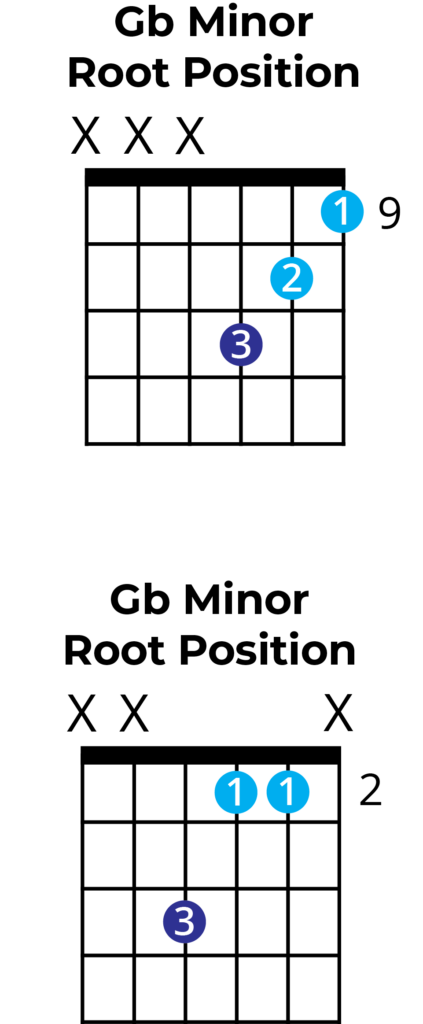
1st Inversion
A 1st inversion is where we take a triad but we start on the second note, which in this case is B double flat. We still keep the D flat above, but then the G flat (or root) become the highest note.
This way of rearranging a triad gives us a different sound as the relative pitches of the three notes has changed.
- B double flat – lowest note
- D flat – middle note
- G flat – highest note
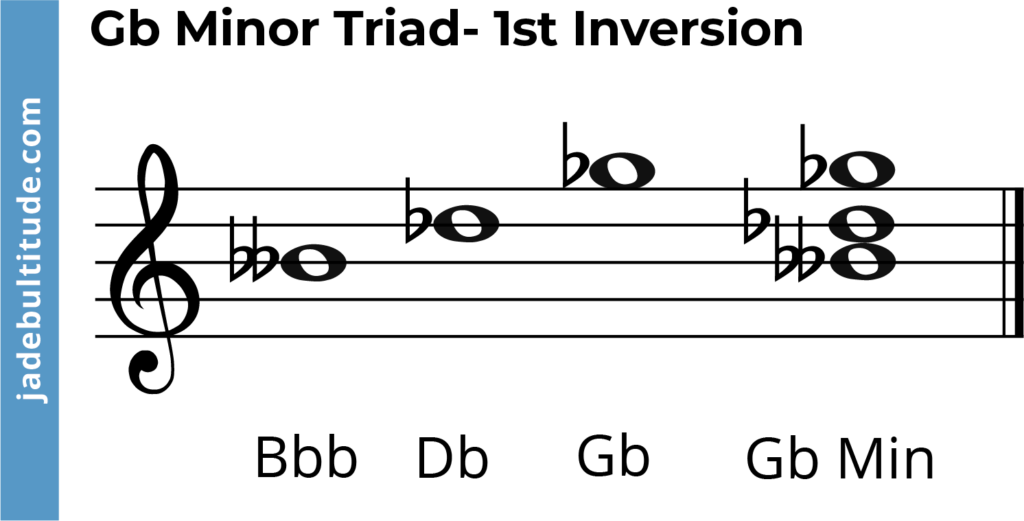
1st inversion on Piano
On the piano we can play the 1st inversion of a Gb Minor triad by starting on an Bbb. They play the Db above and the Gb above this.

1st Inversion on Guitar
Below are the most common shapes for playing a Gb minor triad in the 1st inversion. Remember that we can only use certain shapes are the pitches of the three notes are important.
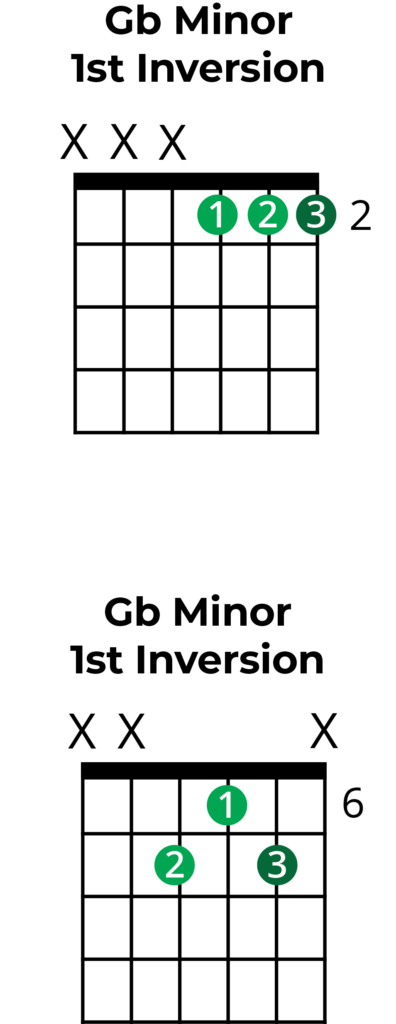
2nd Inversion
A 2nd inversion is where we take a triad but we start on the third note, which in this case is D flat. We still keep the G flat above this as we did from the 1st inversion. Then the B double flat becomes the highest note in the chord.
- Db – perfect 5th (lowest note)
- Gb – root note (middle note)
- Bbb – minor 3rd (highest note)
We could construct a 2nd inversion starting on any Db note in any octave. The only thing that must stay the same is that the we use the Gb above and the Bbb above that.
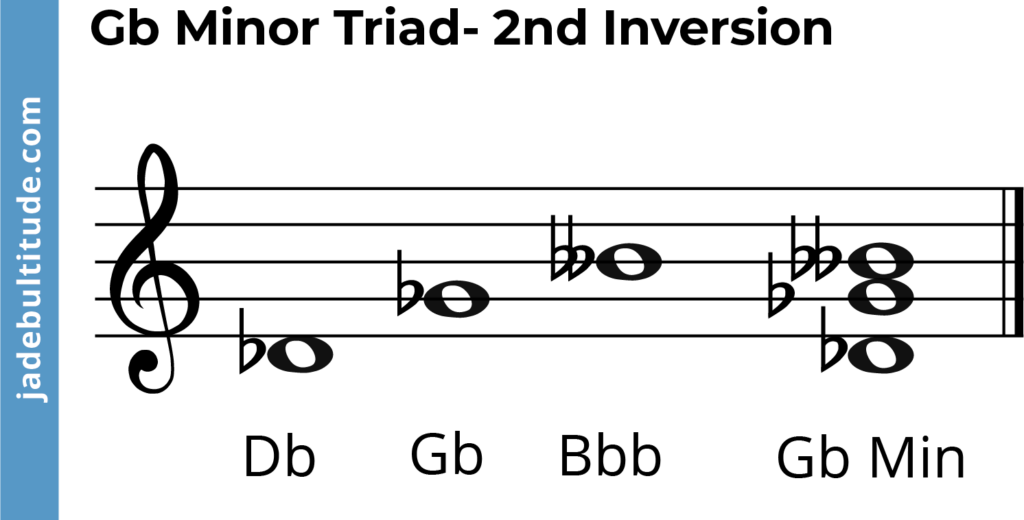
2nd inversion on Piano
On the piano we can play the 2nd inversion of a Gb Minor triad by starting on a Db. They play the Gb above and the Bbb above this.

2nd Inversion on Guitar
Below are the most common shapes for playing a G flat minor chord in the 2nd inversion. Remember that we can only use certain shapes are the pitches of the three notes are important.
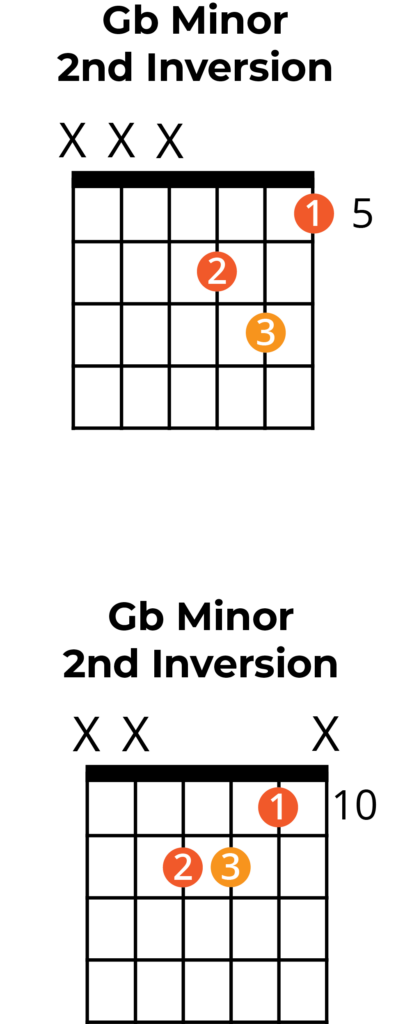
Triads from the G flat Minor Scale
By looking at the G flat Minor scale we can actually make triads built on each note and only using notes from G flat minor. Below you can see a list of each triad we will create be starting on different notes of the scale.
- Gb Minor
- Ab Dim
- Bb Major
- Cb Minor
- Db Minor
- Eb Major
- F Major

Pieces in G flat Minor
Here are several pieces written in the key of G flat Minor. Many composers prefer this key to the enharmonically equivalent key of A flat minor (which has 7 flats).
Sonata No.2 in G-sharp Minor -Scriabin
This piece took 5 years to write and was finally published in 1898. It widely considered to be one of Scriabin’s most popular pieces and is technically and musically demanding to play.
Étude Op. 25, No. 6- Chopin
Étude Op. 25, No. 6, in G-sharp minor, is a challenging technical study with a primary focus on the rapid trilling of thirds. Also referred to as the Double Thirds Étude, it holds the distinction of being regarded as one of the most demanding compositions among Chopin’s 24 Études
It ranks in the top tier of difficulty in accordance with the Henle difficulty rankings.
La Campenella – Franz Liszt
‘La Compenella’ is the nickname for Franz Liszt’s third of six Grandes études de Paganini, S. 141 (1851).
This composition, widely regarded as one of the most technically demanding in the piano repertoire, is a revision of Liszt’s earlier work from 1838, known as the Études d’exécution transcendente d’après Paganini, S. 140.
What’s next….?
- Learn how to construct the G flat Major triad
- Swat up on your chord knowledge with our complete guide to chords.
